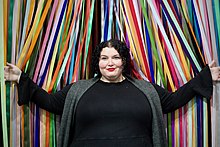Meg Elison
Meg Elison | |
|---|---|
 Elison, at the San Francisco pop-up art exhibit Color Factory, 2017. | |
| Born | May 10th 1982 |
| Occupation | Writer |
| Nationality | USA |
| Alma mater | Mount San Jacinto College; UC Berkeley |
| Website | |
| megelison.com | |
Meg Elison is an American author and feminist essayist whose writings often incorporate the themes of female empowerment, body positivity, and gender flexibility. Her debut novel, The Book of the Unnamed Midwife, won the 2014 Philip K. Dick Award, and her second novel, The Book of Etta, was nominated for the award in 2017. [1] Elison's work has appeared in several markets, including Fantasy & Science Fiction,[2] Terraform,[3] McSweeney's Internet Tendency,[4] Catapult,[5] and Electric Literature.[6]
Bibliography
Fiction
· The Book of the Unnamed Midwife (June 2014) is a feminist post-apocalyptic examination of the plight of women after a global epidemic. Written primarily in a journal format, the book follows one surviving medical worker as she struggles to find civilization and to provide birth control and medical care to the women that she meets.[7]
·The Book of Etta (February 2017) revisits the community of plague survivors several generations later as a female protagonist strikes out against an oppressive male-dominated regime.[8]
·The third and final book of the series is anticipated for 2019.
Awards/Nominations
·Philip K. Dick Award (Winner: The Book of the Unnamed Midwife, 2014)
·Philip K. Dick Award (Nominated: The Book of Etta, 2017)
Background
A high school dropout, she advanced through the California community college system and eventually graduated from UC Berkeley. She has written and spoken extensively on the poverty that came to inform much of her work.[9]
References
- ^ https://lareviewofbooks.org/article/gender-and-the-apocalypse/#!
- ^ https://www.sfsite.com/fsf/blog/2017/11/28/interview-meg-elison-on-big-girl/
- ^ https://motherboard.vice.com/en_us/contributor/meg-elison
- ^ https://www.mcsweeneys.net/authors/meg-elison
- ^ https://catapult.co/Meg-Elison
- ^ https://electricliterature.com/@megelison
- ^ http://www.slate.com/blogs/browbeat/2016/01/28/the_book_of_the_unnamed_midwife_the_2014_sci_fi_novel_that_eerily_anticipated.html
- ^ https://www.rtbookreviews.com/book-review/book-etta
- ^ http://www.dailycal.org/2016/10/17/meg-elisons-singular-feminist-sci-fi/
